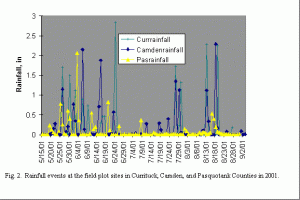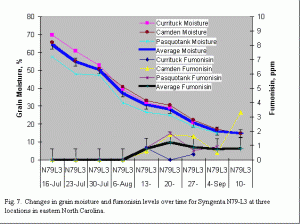Fumonisin: Growning Problem in Corn (Updated 2018)
go.ncsu.edu/readext?355791
en Español / em Português
El inglés es el idioma de control de esta página. En la medida en que haya algún conflicto entre la traducción al inglés y la traducción, el inglés prevalece.
Al hacer clic en el enlace de traducción se activa un servicio de traducción gratuito para convertir la página al español. Al igual que con cualquier traducción por Internet, la conversión no es sensible al contexto y puede que no traduzca el texto en su significado original. NC State Extension no garantiza la exactitud del texto traducido. Por favor, tenga en cuenta que algunas aplicaciones y/o servicios pueden no funcionar como se espera cuando se traducen.
Português
Inglês é o idioma de controle desta página. Na medida que haja algum conflito entre o texto original em Inglês e a tradução, o Inglês prevalece.
Ao clicar no link de tradução, um serviço gratuito de tradução será ativado para converter a página para o Português. Como em qualquer tradução pela internet, a conversão não é sensivel ao contexto e pode não ocorrer a tradução para o significado orginal. O serviço de Extensão da Carolina do Norte (NC State Extension) não garante a exatidão do texto traduzido. Por favor, observe que algumas funções ou serviços podem não funcionar como esperado após a tradução.
English
English is the controlling language of this page. To the extent there is any conflict between the English text and the translation, English controls.
Clicking on the translation link activates a free translation service to convert the page to Spanish. As with any Internet translation, the conversion is not context-sensitive and may not translate the text to its original meaning. NC State Extension does not guarantee the accuracy of the translated text. Please note that some applications and/or services may not function as expected when translated.
Collapse ▲R.W. Heiniger, Cropping Systems Specialist, NCSU – Vernon G. James Research and Extension Center
F.E. O’Neal, Camden County Extension Agent, North Carolina Cooperative Extension Service.
The existence of the mycotoxin fumonisin was discovered in 1988 by a group of researchers in southern Africa while investigating the cause of high esophageal cancer rates in that region. While the identification of the organism is fairly new, it has been suspected as the culprit of human and animal disease as far back as the early 1900’s. Fumonisin is a metabolic product of the Fusarium (fusarium moniliforme) fungi. Fusarium (fusarium moniliforme) fungi is found in the soil and affects many different crops. Fusarium can be transferred systemically into the plant through the roots, can enter the ear through the silks by air or rainfall, or it can enter through insect damage. Environmental conditions such as drought, high temperatures, and insect feeding can cause stress to the corn plant and can increase the likelihood that Fusarium will infect the corn kernel.
Fumonisin causes weight loss, abortions, and cancer in animals and humans. Due to a growing concern about the toxic effects of fumonisin on animals and humans, the Food and Drug Administration (FDA) is seeking to place limits on the amount of fumonisin allowed in samples of corn grain. In 1999, the FDA published suggested regulations concerning the levels of fumonisin it would allow in grain. These levels are 5 ppm for human or equine consumption, 10 ppm for swine, and 50 ppm for cattle and poultry. Based on testing of grain samples from fields in eastern North Carolina that showed fumonisin levels over 20 ppm it quickly became clear that these regulations would pose serious problems for corn growers. It became important to find information on the infection of corn by Fusarium moniliforme, the development of fumonisin in the corn kernel, and how to avoid or eliminate fumonisin contamination of grain. Unfortunately, there was little or no information available on fumonisin development. Therefore, the North Carolina Extension Service took the initiative to conduct field tests to determine how fumonisin develops in corn and what management practices could be used to reduce or eliminate fumonisin contamination. This paper describes the results of these field tests.
Differences in Fumonisin Levels across Years
The highest levels of fumonisin were found in 1999 with intermediate levels found in 2000 and low levels found in 2001 (Fig. 1). Previously, it had been thought that fumonisin levels were related to environmental conditions and were triggered by droughty conditions during grainfill followed by rainfall and high humidity during the harvest period. This study indicates that this line of reasoning is not entirely accurate.
While fumonisin levels were highest in 1999 when drought occurred just prior to silking, damaging levels of fumonisin were found in 2000, a year with above average rainfall during the growing season. The lowest levels of fumonisin occurred in 2001 which was characterized by minimal but timely rains during the growing season followed by dry weather starting in late August (Fig. 2). It is clear that fumonisin levels differ by year based on the environment. It is still not entirely clear what combination of environmental factors were most import in influencing fumonisin development in these studies. Drought during the growing season, though important, is clearly not the only or even the major cause of fumonisin development in corn. Further discussion of enviromental effects on fumonisin development based on data collected in 2001 can be found later in this paper.
Differences in Fumonisin Levels across Hybrids
Statistical analysis of a limited number of hybrids across years (three hybrids) and of a large sampling of hybrids in 2000 indicates that there were differences in fumonisin levels among the hybrids used in this study. When tested from 1999 to 2001, the hybrid Pioneer ‘32Z18’ had significantly higher levels of fumonisin in the grain than did either Pioneer ‘34K77’ or Syngenta ‘N79-L3’. In 1999, fumonisin levels ranged from 10 ppm to 250 ppm. The levels of fumonisin for the individual hybrids utilized for the test were DeKalb ‘DK595 BTY’ with 30 ppm, Pioneer 32Z18 with 250 ppm, Mycogen ‘2832 IMI’ with 36 ppm, Pioneer ‘34B23’ with 90 ppm, Pioneer ‘34T14 PDR’ with 10 ppm and Syngenta ‘4640 bt’ with 26 ppm.
At the early harvest date (9 Aug.) in 2000, Pioneer 32Z18 and DeKalb DK595 had significantly higher levels of fumonisin than ten of the fourteen hybrids tested (Fig. 3). Grain samples from both of these hybrids had fumonisin contamination that would have prevented feeding these hybrids to swine. Two other hybrids, Syngenta 4640bt and DeKalb ‘DK585’ had intermediate levels of fumonisin. At the late harvest date (18 Sept.), only Pioneer 32Z18 had fumonisin levels that were significantly higher than the remaining thirteen hybrids tested (Fig. 4). Of these remaining thirteen hybrids only three, Pioneer ‘34A55’, Pioneer ‘33K81’, and Syngenta N79-L3 had fumonisin levels below the threshold established for swine (10 ppm). 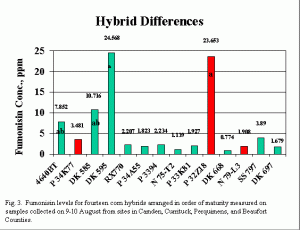
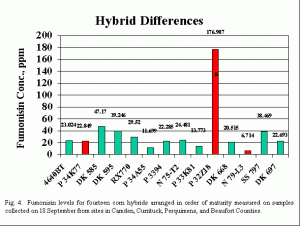
Comparisons of fumonisin levels with grain yield found that there was a relationship between fumonisin contamination and yield. Pioneer 32Z18 had significantly higher levels of fumonisin and had one of the lowest yield records in 2000 (Fig. 5). On the other hand, Syngenta N79-L3 had the lowest level of fumonisin contamination but was one of the highest yielding hybrids. The result was a significant difference in yield between these two hybrids that was similar to the difference in fumonisin levels. The most likely explanation for the relationship between fumonisin levels and grain yield is that the Fusarium ear rot fungus reduces kernel weight and yield as it infects and destroys the kernel. It appears that high levels of fumonisin are linked to reductions in grain yield.
These data indicate that hybrids differ in their susceptibility to fumonisin contamination. While there is no way to determine whether these hybrid differences were due to the physical characteristics of the plant or to resistance to the fusarium fungus, based on the consistent differences across years and upon the lack of a relationship to hybrid maturity it is clear that there are inherent differences that could be manipulated through plant breeding.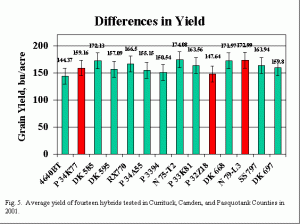
Relationships Between Kernel Moisture, Environmental Conditions, Harvest Date, and Fumonisin Levels
In an effort to find management practices that could be used to reduce or eliminate fumonisin contamination the main study in 2001 focused on the relationships between kernel moisture, environmental conditions throughout the growing and harvest period, harvest date, and fumonisin levels. The two key questions were: 1) Could a grower harvest early enough to avoid or reduce fumonisin contamination and 2) What environmental factors, rainfall, temperature, or relative humidity (RH), tend to trigger a rapid increase in fumonisin levels. Sequential harvests of grain samples found that across hybrids fumonisin levels began to increase between 6 August and 13 August (Figs. 6 and 7). Although the fumonisin levels differed by hybrid, all hybrids showed some fumonisin contamination beginning on 13 August. The increase in fumonisin levels after 13 August was rapid and continued until approximately 27 August before leveling off or, in some cases, decreasing. Unfortunately, a comparison between grain moisture and the date when fumonisin levels begin to increase rapidly shows that for all three hybrids grain moisture was between 35 and 40%. Since blacklayer usually occurs at a grain moisture level of 30 to 33%, this shows that fumonisin accumulation begins at the time that the blacklayer or physiological maturity occurs. Corn at this stage is too wet to harvest efficiently or economically. Therefore, there is very little or no chance that growers could have harvested early enough to avoid fumonisin contamination entirely. Since fumonisin levels increased rapidly over the next 7 to 14 d, it would have been difficult for growers with substantial acreage to even use early harvest to reduce fumonisin levels. However, if growers could determine which fields would be prone to develop fumonisin 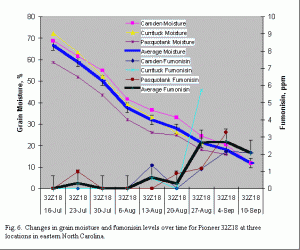 contamination. They could harvest these areas first and have a reasonable chance of reducing fumonisin levels in the grain. When the timeline of changes in fumonisin levels (Figs. 6 and 7) is compared to daily rainfall (Fig. 2), temperature (Fig. 8), and RH (Fig. 9) records for the three locations (Camden, Currituck, and Pasquotank Counties) the most striking environmental event as it relates to fumonisin development is the rainfall that occurred on 12 and 13 August at all locations. These rainfall events were accompanied by increases in RH and short term decreases in temperature. Immediately prior to these rainfall events temperatures had increased dramatically reaching their highest point for the summer early August. It is clear from these weather data that the key factor in fumonisin development in 2001 was rainfall accompanied by warm temperatures following physiological maturity of the crop. These factors were sufficient to increase fumonisin levels even though little or no drought or temperature stress occurred during the growing season. These results may explain why fumonisin levels were so high in 1999 when hurricanes brought an increase in rainfall during the harvest period and in 2000 when rainfall levels were high during late August and early September.
contamination. They could harvest these areas first and have a reasonable chance of reducing fumonisin levels in the grain. When the timeline of changes in fumonisin levels (Figs. 6 and 7) is compared to daily rainfall (Fig. 2), temperature (Fig. 8), and RH (Fig. 9) records for the three locations (Camden, Currituck, and Pasquotank Counties) the most striking environmental event as it relates to fumonisin development is the rainfall that occurred on 12 and 13 August at all locations. These rainfall events were accompanied by increases in RH and short term decreases in temperature. Immediately prior to these rainfall events temperatures had increased dramatically reaching their highest point for the summer early August. It is clear from these weather data that the key factor in fumonisin development in 2001 was rainfall accompanied by warm temperatures following physiological maturity of the crop. These factors were sufficient to increase fumonisin levels even though little or no drought or temperature stress occurred during the growing season. These results may explain why fumonisin levels were so high in 1999 when hurricanes brought an increase in rainfall during the harvest period and in 2000 when rainfall levels were high during late August and early September.
From a management standpoint, it appears from this data that very little can be done to avoid fumonisin contamination by harvesting early. It would also be difficult to adjust planting practices to avoid stress or rainfall during harvest. Hopefully, this information could be used to screen hybrids to determine if genetic differences in physical characteristics or disease resistance could be manipulated to reduce fumonisin development.
Quick Methods for Determining Fumonisin Levels in the Field
Visual ratings of hybrids in 1999 and 2000 were made to determine if fumonisin contamination could be detected and levels determined through simple visual evaluation. When fumonisin levels (Figs. 3 and 4) for fourteen different hybrids were compared to a visual rating of ear samples (Fig. 10) there was a clear relationship between fumonisin levels and visual rating within each sample date. It was possible to determine the relative difference in the amount of fumonisin in the grain by visual score. However, the visual scores were not useful in determining the absolute level of fumonisin in the grain sample. Therefore, to determine if the levels of fumonisin in a grain sample exceeded a threshold value a laboratory analysis would have to be done on a test sample and the visual scores for the remaining samples would have to be compared with that sample taken at the same time and location. This makes this method impractical for determining if grain can be sold for a given purpose. However, this method would allow growers to determine which fields have a problem and need immediate harvest.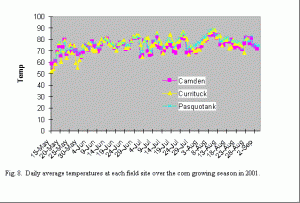
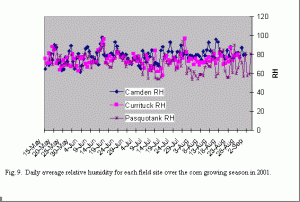
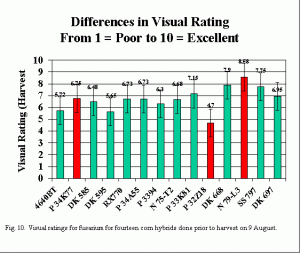
SUMMARY
- It is clear that given the levels at which the FDA proposes to regulate fumonisin contamination in corn, fumonisin will be a problem for North Carolina corn growers almost every season. There was no case in this study where fumonisin was entirely absent from corn grain grown in eastern North Carolina. In two of the three years, grain from most of the hybrids tested would have been over the FDA limit for swine, equine, and human consumption. The best that can be achieved is the reduction of fumonisin levels below thresholds for animal and human consumption.
- There are differences among hybrids in susceptibility to the development of fumonisin. Hybrids such as Pioneer 32Z18 appear to always have higher levels than hybrids such as Pioneer 34K77 or Syngenta N79-L3. While no hybrid in these tests was entirely free from fumonisin, breeders should be able to find materials with better tolerance. While these studies did not indicate the mechanism for hybrid resistance, based on the rapid response of fumonisin to rainfall in 2001 it appears that resistance is gained through physical attributes of the plant such as better shuck coverage or a thicker shuck.
- Fumonisin development is primarily caused by warm, moist conditions following the formation of the blacklayer in the corn kernel. Therefore, rainfall and warm weather during August and early September stimulate fumonisin development. Environmental conditions such as drought are not necessary for fumonisin development but do help increase the level of fumonisin in the grain.
- Growers are limited in the management tools available for reducing fumonisin contamination. While early harvest could help reduce fumonisin levels, it would be difficult to harvest the entire crop early enough to avoid fumonisin. Once ideal environmental conditions are achieved, fumonisin develops rapidly. This will make it difficult to use early harvest as the primary tool in reducing fumonisin levels. The best option would be for growers to identify fields that are at risk and then harvest those first. The best management option for reducing fumonisin is to select hybrids with some resistance. Unfortunately, there is little reliable information that can be used to make a good hybrid selection for fumonisin resistance. The information gained from this study is a good first step, but must be followed up with subsequent tests. Seed corn providers must be encouraged to provide hybrid ratings for fusarium.
- Visual inspection could be used to identify fields where fusarium is developing and where fumonisin is a potential problem. To make practical use of this tool biweekly inspections would be required beginning at physiological maturity and continuing until the crop is harvested. These inspections would be useful in targeting harvest and could be triggered by alerts from county extension offices based on weather conditions.
- Future work should focus on four areas: 1) a study of the mechanisms of hybrid resistance, 2) the development of breeding programs based on knowledge of resistance mechanisms aimed at reducing fumonisin levels in corn, 3) a better understanding of the effects of fumonisin on livestock performance and health that would lead to realistic thresholds for fumonisin in grain, and 4) a survey of grain samples taken over several years from across North Carolina to determine where fumonisin is a likely problem from year-to-year and to develop a strategy for marketing grain which will enhance the value of North Carolina corn (For instance: corn from areas prone to fumonisin contamination could be directed to ethanol production).




